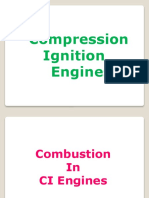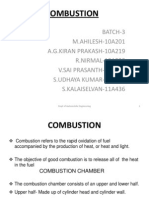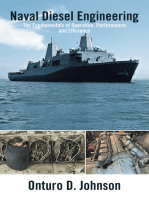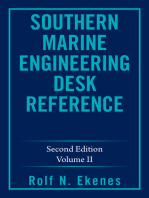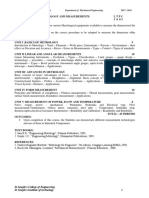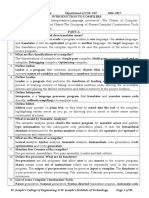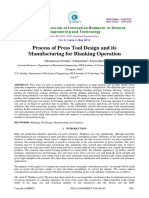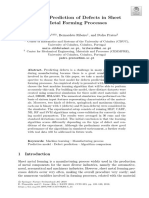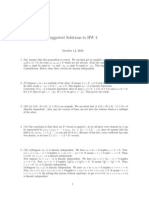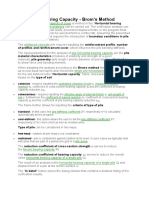Combustion in SI Engines
Combustion in SI Engines
Uploaded by
amdevaCopyright:
Available Formats
Combustion in SI Engines
Combustion in SI Engines
Uploaded by
amdevaOriginal Description:
Original Title
Copyright
Available Formats
Share this document
Did you find this document useful?
Is this content inappropriate?
Copyright:
Available Formats
Combustion in SI Engines
Combustion in SI Engines
Uploaded by
amdevaCopyright:
Available Formats
ME2041 Advanced Internal Combustion Engines
Combustion in SI Engines
Combustion is the process of oxidation of fuel resulting into the
release of energy equivalent to calorific value of fuel. Energy released
in combustion is in the form of heat.
Combustion process in spark ignition engine has requirement of the
mixture of fuel and air in right proportion
mechanism for initiation of combustion process and
stabilization and propagation of flame for complete burning
For complete combustion of every fuel there is chemically correct fuelair ratio also called stoichiometric fuel-air ratio.
This fuel air ratio may be rich or lean depending upon the proportion of
fuel and air present in mixture. In SI engine this fuel air ratio generally
varies between 1 : 7 to 1 : 30 with lean mixture at 1 : 30 and rich mixture
at 1 : 7.
Stoichiometric fuel-air ratio is around 1 : 14 to 1 : 15 for hydrocarbon
fuel. The extreme values of fuel-air ratio permissible in SI engine on
both rich and lean ends put limits as lower ignition limit and upper
ignition limit.
Unit I
Department of Mechanical Engineering, St. Josephs College of Engineering
ME2041 Advanced Internal Combustion Engines
Combustion in SI Engines
Varying fuel-air ratio is required in SI engine due to varying loads on
engine between no load to full load on engine. The ratio of actual fuel-air
ratio to stoichiometic fuel-air ratio is given by equivalence ratio or
relative fuel-air ratio.
Appropriate fuel-air ratio is maintained in SI engines through
carburettor (the fuel metering system).
Unit I
Department of Mechanical Engineering, St. Josephs College of Engineering
ME2041 Advanced Internal Combustion Engines
Stages of Combustion in SI Engines
Unit I
Department of Mechanical Engineering, St. Josephs College of Engineering
ME2041 Advanced Internal Combustion Engines
Stages of Combustion in SI Engines
Combustion in SI engine may be described to be occurring in following
significant phase:
(i)preparation phase
After compression of fuel-air mixture in cylinder the high temperature spark
is delivered by spark plug in the compressed fuel-air mixture. Temperature at
the tip of spark plug electrode may go even more than 10,000C at the time
of release of spark.
Sparkles released have sufficiently high temperature to initiate the
combustion of fuel. For complete combustion of fuel mere initiation of
combustion does not serve the purpose instead a sustainable combustion
process is required.
After setting up of combustion a sustainable flame front or flame nuclei is
needed so that it proceeds across the combustion space to ensure complete
combustion. Thus, this phase in which spark is first released followed by
setting up of sustainable flame front is called preparation phase and may
consume around 10 of crank angle rotation.
Unit I
Department of Mechanical Engineering, St. Josephs College of Engineering
ME2041 Advanced Internal Combustion Engines
Stages of Combustion in SI Engines
Crank angle rotation consumed in preparation phase depends upon the
speed of engine, constructional feature of cylinder, piston, location of spark
plug, strength of spark, characteristics of fuel, fuel-air ratio etc.
Preparation phase is shown to occur from a to b with small or negligible
pressure rise as initially rate of burning is very small.
(ii) Flame Propagation Phase
After sustainable combustion flame is set up then the flame nuclei get
scattered due to excessive turbulence in combustion space causing
pressure to rise from b to c.
This phase of combustion depends upon the turbulence inside cylinder,
strength of compbustion nuclei, fuel-air ratio, strength of spark, cylinder
geometry, fuel properties etc.
This phase of combustion is called as flame propagation phase and is
accompanied by the excessive pressure rise. Flame propagation phase
should also be as small as possible.
Unit I
Department of Mechanical Engineering, St. Josephs College of Engineering
ME2041 Advanced Internal Combustion Engines
Stages of Combustion in SI Engines
(iii) After Burning Phase
After the maximum amount of fuel-air mixture is burnt, the residual gets
burnt after the piston has moved across the TDC.
This last phase is termed as after burning phase and occurs during the
expansion stroke.
Hence, it can be summarised that the complete combustion in SI engine
occurs in three distinct zones i.e. preparation phase, flame propagation
phase and after burning phase.
In order to complete combustion in smallest possible time the flame
propagation phase and preparation phase should be shortened.
Out of total distance travelled in combustion space in first phase i.e.
Preparation phase about 10% of combustion space length is covered in
about 2030% of total time for combustion.
Unit I
Department of Mechanical Engineering, St. Josephs College of Engineering
ME2041 Advanced Internal Combustion Engines
Stages of Combustion in SI Engines
Flame propagation phase is spread in about 80% of combustion space
length and is covered in 6070% of total time of combustion.
After burning occurs in less than 10% of combustion space in less than
10% of total combustion time.
Abnormal Combustion
Combustion may also sometimes occur abnormally. Abnormal combustion
is said to occur when combustion begins inside the cylinder on its own
before the stipulated time for it.
This abnormal combustion may be due to pre-ignition (i.e. ignition of fuel
even before spark plug ignites it) or auto-ignition (i.e. Ignition of fuel due to
hot spots in the combustion space like valve seats, spark plug) and results
in uncontrolled pressure rise.
Abnormal combustion is also termed as detonation or knocking and can be
felt by jerky operation of engine, excessive noise, reduced power output etc
Unit I
Department of Mechanical Engineering, St. Josephs College of Engineering
ME2041 Advanced Internal Combustion Engines
Factors affecting knock
Fuel
A low self ignition temperature fuel promotes knock.
Induction pressure
Increase of pressure decreases SIT and increases induction time; tendency of knock
increases. Eg. At full throttle knock tends to occur more.
Engine Speed
Low engine speed will give low turbulence and low flame velocity and hence knock
tendency is more.
Ignition Timing
Advancing ignition timing increases peak pressure and promotes knock.
Compression Ratio
High compression ratio increases cylinder pressures and increases the tendency for
knock.
Combustion Chamber Design
Poor design results in long flame path, low turbulence and insufficient cooling all of
which increase knock tendency.
Cylinder Cooling
Poor cylinder cooling increases the temperature and hence the chances of knock
temperature fuel promotes knock.
Unit I
Department of Mechanical Engineering, St. Josephs College of Engineering
ME2041 Advanced Internal Combustion Engines
Combustion Chambers
Unit I
Department of Mechanical Engineering, St. Josephs College of Engineering
ME2041 Advanced Internal Combustion Engines
Combustion Chambers
Unit I
Department of Mechanical Engineering, St. Josephs College of Engineering
ME2041 Advanced Internal Combustion Engines
Combustion Chambers
Unit I
Department of Mechanical Engineering, St. Josephs College of Engineering
ME2041 Advanced Internal Combustion Engines
Combustion Chambers
Unit I
Department of Mechanical Engineering, St. Josephs College of Engineering
ME2041 Advanced Internal Combustion Engines
Combustion Chambers
Unit I
Department of Mechanical Engineering, St. Josephs College of Engineering
ME2041 Advanced Internal Combustion Engines
Combustion Chambers
Unit I
Department of Mechanical Engineering, St. Josephs College of Engineering
ME2041 Advanced Internal Combustion Engines
Combustion Chambers
Unit I
Department of Mechanical Engineering, St. Josephs College of Engineering
ME2041 Advanced Internal Combustion Engines
Combustion Chambers
Unit I
Department of Mechanical Engineering, St. Josephs College of Engineering
ME2041 Advanced Internal Combustion Engines
Combustion Chambers
Unit I
Department of Mechanical Engineering, St. Josephs College of Engineering
ME2041 Advanced Internal Combustion Engines
THERMODYNAMIC ANALYSIS OF SI ENGINE
COMBUSTION
Burned and Unburned Mixture States
Because combustion occurs through a flame propagation
process, the changes in
state and the motion of the unburned and burned gas are much
more complex
than the ideal cycle analysis.
The gas pressure, temperature,and density change as a result of
changes in volume due to piston motion.
During combustion, the cylinder pressure increases due to the
release of the fuel's
chemical energy.
As each element of fuel-air mixture bums, its density decreases
by about a factor of four.
This combustion-produced gas expansion compresses the
unburned mixture ahead of the flame and displaces it toward
the combustion chamber walls.
The
combustion-produced
gas expansion also compresses those
Unit
I
Department of Mechanical Engineering, St. Josephs College of Engineering
parts of the charge which have already burned, and displaces
ME2041 Advanced Internal Combustion Engines
THERMODYNAMIC ANALYSIS OF SI ENGINE
COMBUSTION
Burned and Unburned Mixture States
During the combustion process, the unburned gas elements
move away from the spark plug; following combustion,
individual gas elements move back toward the spark plug.
Further, elements of the unburned mixture which burn at
different times have different pressures and temperatures just
prior to combustion, and therefore end up at different states
after combustion.
The thermodynamic state and composition of the burned gas is,
therefore, non-uniform.
A first law analysis of the spark-ignition engine combustion
process enables us to
quantify these gas states.
Work transfer occurs between the cylinder gases and the piston
(to the gas before TC; to the piston after TC).
Unit I
Department of Mechanical Engineering, St. Josephs College of Engineering
ME2041 Advanced Internal Combustion Engines
THERMODYNAMIC ANALYSIS OF SI ENGINE
COMBUSTION
Burned and Unburned Mixture States
Heat transfer occurs to the chamber walls, primarily from the
burned gases.
At the temperatures and pressures typical of spark-ignition
engines it is a reasonable approximation to assume that the
volume of the reaction zone where combustion is actually
occurring is a negligible fraction of the chamber volume even
though the thickness of-the turbulent flame may not be
negligible compared with the chamber dimensions.
With normal engine operation, at any point in time or crank
angle, the pressure throughout the cylinder is close to uniform.
The conditions in the burned and unburned gas are then
determined by conservation of mass :
Unit I
Department of Mechanical Engineering, St. Josephs College of Engineering
ME2041 Advanced Internal Combustion Engines
THERMODYNAMIC ANALYSIS OF SI ENGINE
COMBUSTION
Burned and Unburned Mixture States
The conservation of energy:
where V is the cylinder volume, m is the mass of the cylinder
contents, v is the specific volume, xb is the mass fraction
burned, Uo is the internal energy of the cylinder contents
at some reference point 0, u is the specific internal energy,
W is the work done on the piston, and Q is the heat transfer to
the walls. The subscripts u and b denote unburned and
burned gas properties, respectively.
The work and heat transfers are:
Where
walls.
Unit I
is the instantaneous heat-transfer rate to the chamber
Department of Mechanical Engineering, St. Josephs College of Engineering
ME2041 Advanced Internal Combustion Engines
THERMODYNAMIC ANALYSIS OF SI ENGINE
COMBUSTION
Burned and Unburned Mixture States
Useful results can be obtained by assuming that the burned and
unburned gases are different ideal gases, each with constant
specific heats. i.e.
Combining these eqns.
Unit I
Department of Mechanical Engineering, St. Josephs College of Engineering
ME2041 Advanced Internal Combustion Engines
THERMODYNAMIC ANALYSIS OF SI ENGINE
COMBUSTION
Burned and Unburned Mixture States
The above equations may be solved to obtain
If we now assume the unburned gas is initially uniform and
undergoes isentropic compression, then
Unit I
Department of Mechanical Engineering, St. Josephs College of Engineering
You might also like
- Decision Making Under Uncertainty: Maximax CriterionNo ratings yetDecision Making Under Uncertainty: Maximax Criterion6 pages
- Nandha Engineering College (Autonomous) : 17mex12 - Internal Combustion EnginesNo ratings yetNandha Engineering College (Autonomous) : 17mex12 - Internal Combustion Engines36 pages
- Syllabus:: Unit I Spark Ignition EnginesNo ratings yetSyllabus:: Unit I Spark Ignition Engines41 pages
- Lecture - 3 Combustion Phases of SI and CI EnginesNo ratings yetLecture - 3 Combustion Phases of SI and CI Engines21 pages
- Combustion in Compression Ignition EngineNo ratings yetCombustion in Compression Ignition Engine20 pages
- Combustion, Exhaust, HT & Lubrication in SI ENGINES100% (1)Combustion, Exhaust, HT & Lubrication in SI ENGINES158 pages
- Internal Combustion Engines ME 4142: Dr. Saif Ur Rahman Department of Mechanical EngineeringNo ratings yetInternal Combustion Engines ME 4142: Dr. Saif Ur Rahman Department of Mechanical Engineering66 pages
- ME2041 Advanced Internal Combustion Engines: Unit INo ratings yetME2041 Advanced Internal Combustion Engines: Unit I21 pages
- ME6016 Advanced Internal Combustion Engines: SyllabusNo ratings yetME6016 Advanced Internal Combustion Engines: Syllabus41 pages
- Chapter 4 Combustion and Combustion Chamber Design NotesNo ratings yetChapter 4 Combustion and Combustion Chamber Design Notes18 pages
- Wk7-TR2019-Ch 4 Part 1b - SI Engine CombustionNo ratings yetWk7-TR2019-Ch 4 Part 1b - SI Engine Combustion52 pages
- Thermodynamic Analysis of Si Engine Combustion: ME2041 Advanced Internal Combustion EnginesNo ratings yetThermodynamic Analysis of Si Engine Combustion: ME2041 Advanced Internal Combustion Engines6 pages
- Chapter 4 Combustion and Combustion Chamber DesignNo ratings yetChapter 4 Combustion and Combustion Chamber Design42 pages
- Means & Methods To Promote Matured Combustion .: Design & Analysis of Combustion System For Diesel EnginesNo ratings yetMeans & Methods To Promote Matured Combustion .: Design & Analysis of Combustion System For Diesel Engines21 pages
- Chapter 4 Combustion and Combustion Chamber DesignNo ratings yetChapter 4 Combustion and Combustion Chamber Design40 pages
- ME2041 Advanced Internal Combustion EnginesNo ratings yetME2041 Advanced Internal Combustion Engines34 pages
- Unit IV & V - I.C. Engine and CombustionNo ratings yetUnit IV & V - I.C. Engine and Combustion78 pages
- Naval Diesel Engineering: The Fundamentals of Operation, Performance and EfficiencyFrom EverandNaval Diesel Engineering: The Fundamentals of Operation, Performance and EfficiencyNo ratings yet
- Southern Marine Engineering Desk Reference: Second Edition Volume IiFrom EverandSouthern Marine Engineering Desk Reference: Second Edition Volume IiNo ratings yet
- Suggested Student Progress Tracker For Motion and TimeNo ratings yetSuggested Student Progress Tracker For Motion and Time1 page
- CS6660-Compiler Design Department of CSE &IT 2016-2017No ratings yetCS6660-Compiler Design Department of CSE &IT 2016-201715 pages
- ME 6504 Metrology and Measurements Department of Mechanical Engineering 2017 - 2018No ratings yetME 6504 Metrology and Measurements Department of Mechanical Engineering 2017 - 201815 pages
- CS6660-Compiler Design Department of CSE &IT 2016-2017No ratings yetCS6660-Compiler Design Department of CSE &IT 2016-201715 pages
- ME 6504 Metrology and Measurements Department of Mechanical Engineering 2017 - 2018No ratings yetME 6504 Metrology and Measurements Department of Mechanical Engineering 2017 - 201815 pages
- Unit-I Introduction To Compilers: CS6660-Compiler Design Department of CSE &IT 2016-2017No ratings yetUnit-I Introduction To Compilers: CS6660-Compiler Design Department of CSE &IT 2016-201795 pages
- Unit-I Introduction To Compilers: CS6660-Compiler Design Department of CSE &IT 2016-2017No ratings yetUnit-I Introduction To Compilers: CS6660-Compiler Design Department of CSE &IT 2016-201795 pages
- Process of Press Tool Design and Its Manufacturing For Blanking OperationNo ratings yetProcess of Press Tool Design and Its Manufacturing For Blanking Operation8 pages
- CE 6306 / Strength of Materials Mechanical Engineering 2016-17No ratings yetCE 6306 / Strength of Materials Mechanical Engineering 2016-176 pages
- Evaluation of Digital Photography From Model Aircraft For Remote Sensing of Crop Biomass and Nitrogen StatusNo ratings yetEvaluation of Digital Photography From Model Aircraft For Remote Sensing of Crop Biomass and Nitrogen Status21 pages
- 1919 - Hoxton - The Joule Thompson Effect For Air at Moderate Temperatures and Pressures PDFNo ratings yet1919 - Hoxton - The Joule Thompson Effect For Air at Moderate Temperatures and Pressures PDF42 pages
- Ghouse Moinuddin Mohammad Email: - Phone: (872) 228-9552 Professional SummaryNo ratings yetGhouse Moinuddin Mohammad Email: - Phone: (872) 228-9552 Professional Summary9 pages
- Model Prediction of Defects in Sheet Metal Forming ProcessesNo ratings yetModel Prediction of Defects in Sheet Metal Forming Processes12 pages
- Linear Algebra, Fried Berg, 4th Editoion Solutions 1.5 (8a, 9, 10, 11, 13, 14, 16, 18) & 1.6 (10a, 16, 22, 23, 25, 29, 30, 31)No ratings yetLinear Algebra, Fried Berg, 4th Editoion Solutions 1.5 (8a, 9, 10, 11, 13, 14, 16, 18) & 1.6 (10a, 16, 22, 23, 25, 29, 30, 31)5 pages
- Standard Specifications Geotechnical Design Manual: Walls and Buried StructuresNo ratings yetStandard Specifications Geotechnical Design Manual: Walls and Buried Structures10 pages
- IN Physics For Engineers (PHYS 20034) : Prepared and Submitted By: Engr. Hannah Ledda B. FerrerNo ratings yetIN Physics For Engineers (PHYS 20034) : Prepared and Submitted By: Engr. Hannah Ledda B. Ferrer7 pages
- Oracle Database 21c Enterprise Edition Release 21No ratings yetOracle Database 21c Enterprise Edition Release 2125 pages
- Summer Training Report at Atomic Power Station, Rawatbhata100% (2)Summer Training Report at Atomic Power Station, Rawatbhata40 pages
- Department of Agricultural Statistics: JNR MSC Agri, Students, UasdNo ratings yetDepartment of Agricultural Statistics: JNR MSC Agri, Students, Uasd2 pages
- Hardware Co-Simulation of 1024-Point FFT and Its Implementation, in Simulink, Xilinx Vivado IDE On Zynq-7000 FPGANo ratings yetHardware Co-Simulation of 1024-Point FFT and Its Implementation, in Simulink, Xilinx Vivado IDE On Zynq-7000 FPGA7 pages
- A Unified SCR Model For Continuous Topology CADANo ratings yetA Unified SCR Model For Continuous Topology CADA10 pages
- GEO5 Pile Horizontal Bearing Capacity Broms MethodNo ratings yetGEO5 Pile Horizontal Bearing Capacity Broms Method4 pages
- Physics Paper 1: Provided by Dse - LifeNo ratings yetPhysics Paper 1: Provided by Dse - Life16 pages
- Solution of MPPT On Photo-Voltaic Cell Using Different Algorithms100% (1)Solution of MPPT On Photo-Voltaic Cell Using Different Algorithms38 pages
- Decision Making Under Uncertainty: Maximax CriterionDecision Making Under Uncertainty: Maximax Criterion
- Nandha Engineering College (Autonomous) : 17mex12 - Internal Combustion EnginesNandha Engineering College (Autonomous) : 17mex12 - Internal Combustion Engines
- Lecture - 3 Combustion Phases of SI and CI EnginesLecture - 3 Combustion Phases of SI and CI Engines
- Combustion, Exhaust, HT & Lubrication in SI ENGINESCombustion, Exhaust, HT & Lubrication in SI ENGINES
- Internal Combustion Engines ME 4142: Dr. Saif Ur Rahman Department of Mechanical EngineeringInternal Combustion Engines ME 4142: Dr. Saif Ur Rahman Department of Mechanical Engineering
- ME2041 Advanced Internal Combustion Engines: Unit IME2041 Advanced Internal Combustion Engines: Unit I
- ME6016 Advanced Internal Combustion Engines: SyllabusME6016 Advanced Internal Combustion Engines: Syllabus
- Chapter 4 Combustion and Combustion Chamber Design NotesChapter 4 Combustion and Combustion Chamber Design Notes
- Thermodynamic Analysis of Si Engine Combustion: ME2041 Advanced Internal Combustion EnginesThermodynamic Analysis of Si Engine Combustion: ME2041 Advanced Internal Combustion Engines
- Chapter 4 Combustion and Combustion Chamber DesignChapter 4 Combustion and Combustion Chamber Design
- Means & Methods To Promote Matured Combustion .: Design & Analysis of Combustion System For Diesel EnginesMeans & Methods To Promote Matured Combustion .: Design & Analysis of Combustion System For Diesel Engines
- Chapter 4 Combustion and Combustion Chamber DesignChapter 4 Combustion and Combustion Chamber Design
- Naval Diesel Engineering: The Fundamentals of Operation, Performance and EfficiencyFrom EverandNaval Diesel Engineering: The Fundamentals of Operation, Performance and Efficiency
- Southern Marine Engineering Desk Reference: Second Edition Volume IiFrom EverandSouthern Marine Engineering Desk Reference: Second Edition Volume Ii
- Suggested Student Progress Tracker For Motion and TimeSuggested Student Progress Tracker For Motion and Time
- CS6660-Compiler Design Department of CSE &IT 2016-2017CS6660-Compiler Design Department of CSE &IT 2016-2017
- ME 6504 Metrology and Measurements Department of Mechanical Engineering 2017 - 2018ME 6504 Metrology and Measurements Department of Mechanical Engineering 2017 - 2018
- CS6660-Compiler Design Department of CSE &IT 2016-2017CS6660-Compiler Design Department of CSE &IT 2016-2017
- ME 6504 Metrology and Measurements Department of Mechanical Engineering 2017 - 2018ME 6504 Metrology and Measurements Department of Mechanical Engineering 2017 - 2018
- Unit-I Introduction To Compilers: CS6660-Compiler Design Department of CSE &IT 2016-2017Unit-I Introduction To Compilers: CS6660-Compiler Design Department of CSE &IT 2016-2017
- Unit-I Introduction To Compilers: CS6660-Compiler Design Department of CSE &IT 2016-2017Unit-I Introduction To Compilers: CS6660-Compiler Design Department of CSE &IT 2016-2017
- Process of Press Tool Design and Its Manufacturing For Blanking OperationProcess of Press Tool Design and Its Manufacturing For Blanking Operation
- CE 6306 / Strength of Materials Mechanical Engineering 2016-17CE 6306 / Strength of Materials Mechanical Engineering 2016-17
- Evaluation of Digital Photography From Model Aircraft For Remote Sensing of Crop Biomass and Nitrogen StatusEvaluation of Digital Photography From Model Aircraft For Remote Sensing of Crop Biomass and Nitrogen Status
- 1919 - Hoxton - The Joule Thompson Effect For Air at Moderate Temperatures and Pressures PDF1919 - Hoxton - The Joule Thompson Effect For Air at Moderate Temperatures and Pressures PDF
- Ghouse Moinuddin Mohammad Email: - Phone: (872) 228-9552 Professional SummaryGhouse Moinuddin Mohammad Email: - Phone: (872) 228-9552 Professional Summary
- Model Prediction of Defects in Sheet Metal Forming ProcessesModel Prediction of Defects in Sheet Metal Forming Processes
- Linear Algebra, Fried Berg, 4th Editoion Solutions 1.5 (8a, 9, 10, 11, 13, 14, 16, 18) & 1.6 (10a, 16, 22, 23, 25, 29, 30, 31)Linear Algebra, Fried Berg, 4th Editoion Solutions 1.5 (8a, 9, 10, 11, 13, 14, 16, 18) & 1.6 (10a, 16, 22, 23, 25, 29, 30, 31)
- Standard Specifications Geotechnical Design Manual: Walls and Buried StructuresStandard Specifications Geotechnical Design Manual: Walls and Buried Structures
- IN Physics For Engineers (PHYS 20034) : Prepared and Submitted By: Engr. Hannah Ledda B. FerrerIN Physics For Engineers (PHYS 20034) : Prepared and Submitted By: Engr. Hannah Ledda B. Ferrer
- Summer Training Report at Atomic Power Station, RawatbhataSummer Training Report at Atomic Power Station, Rawatbhata
- Department of Agricultural Statistics: JNR MSC Agri, Students, UasdDepartment of Agricultural Statistics: JNR MSC Agri, Students, Uasd
- Hardware Co-Simulation of 1024-Point FFT and Its Implementation, in Simulink, Xilinx Vivado IDE On Zynq-7000 FPGAHardware Co-Simulation of 1024-Point FFT and Its Implementation, in Simulink, Xilinx Vivado IDE On Zynq-7000 FPGA
- GEO5 Pile Horizontal Bearing Capacity Broms MethodGEO5 Pile Horizontal Bearing Capacity Broms Method
- Solution of MPPT On Photo-Voltaic Cell Using Different AlgorithmsSolution of MPPT On Photo-Voltaic Cell Using Different Algorithms













